To each their own, and far be it for me to cast the first stone, but there can be some really annoying people in a symphony audience. But it’s the applauders that I wish to dwell on. There are, for instance, a certain group of people who take it upon themselves to begin clapping at the very instant a piece finishes – sometimes even before – to show not only their appreciation, but either their knowledge of the work in question, their competitiveness to be the first one to make a sound, or a combination of both.
The technical term for these people is ‘idiot’, especially if that particularly fatal mix – of the desire to be the first to clap, but an unfortunate lack of knowledge about the piece – provokes an embarrassing flurry of minor applause before hushing up again. One only hopes they learn their lesson. But there were none of these at the Concert Hall on the night in question. Rather, there was a second lot, exclusively taken from the rank of students (for this was a ‘Meet the Music’ concert of the Sydney Symphony’s, which, at 6.30pm, and presumably through some education-outreach, attracts many a younger viewer in their respective school uniforms). They were more of the ‘last clap wins’ establishment, whereby, after a conductor has been duly applauded onto the platform, there will, around the hall, be a back-and-forth between the sections of single claps, in what ends up sounding like a sarcastic exercise in making popcorn. One clap here, another clap there, a ‘shh’ from a teacher, and so on, and so on. Add to that a general state of restlessness in a sizeable portion of the student body (I’m sure some of the girls sitting in front of me, for instance, where texting their friends further down the row, given how they kept leaning forward to look down said row, and were busy, unsurprisingly, using their phones) and you have the ingredients for a somewhat distracting concert. Yet it was enjoyable enough.
Nicholas Carter, conductor for the evening, is a rather young man himself as well, although he cut quite the dashing figure in a very sharp suit. Most likely known to Sydney audiences for his, as the program tells us, ‘three-year association with the Sydney Symphony, first as Assistant Conductor, working closely with Vladimir Ashkenazy and a number of guest conductors, and subsequently as Associate conductor’, he is now ‘fast establishing a career as a conductor of exceptional versatility’, and is ‘currently Resident conductor of the Hamburg State Opera, as well as serving as musical assistant to Music Director Simone Young’. The technical term (I’m all about the technical terms today) is ‘going places’. His demeanour has changed somewhat since this critic last saw him conduct, as he seems a tad more clean in his movements, a bit more direct and focused. There’s more of a sense of confidence, one would say, which is a very useful aura for a conductor to project – after all, the audience often takes their cue from the conductor directly.
There were five pieces for the evening, and we began with the best of them, Haydn’s Symphony No. 96 in D (Miracle). The symphony earned its miraculous epithet by an anecdote of its premiere, where the audience, so eager to see the composer of such a wonderful piece, crammed to the front of the stage, such that when the huge chandelier fell from its moorings, no one was harmed. Which is a lovely story, and one that’s great for programs to tell, except that it was actually the premiere of the 102nd symphony, four and a half years later, where the chandelier fell on no one. (This persistent mistake is also a great story for programs; indeed, both details come as a package.)
Carter here peaked for the night, pulling from the orchestra an interpretation that was whip-tight, injecting a sense of drama in music that is often less turbulent. Too often nowadays, for this critic at least, a piece by Haydn is something merely to be got through until the more interesting work in a program comes along (and this is through no fault of Haydn’s), so it’s nice to be jolted back to an appreciation.
Lowell Liebermann’s Flute Concerto, Op.39 came next, with Janet Webb, principal flautist of the Sydney Symphony, providing the flute and the person to play it. The problem with a flute concerto is that the orchestra can often overpower the flautist, and while Liebermann has composed his piece – quite a popular one, according to the program – in such a way as to ‘clear out’ certain sections of the orchestra so as to make the flute audible, one was not entirely convinced. The pre-concert speaker enthused about her interpretation that the piece was a war between the flute and the orchestra, with the flute struggling valiantly to win, but to my mind the flute had to resort to guerrilla tactics from the off. The piece as a whole, however, was not an unenjoyable affair, but the best moments happened during the surging and swirling orchestral colours, rather than the soloist’s prominent parts. Webb is clearly virtuosic and talented, but felt somewhat sidelined.
After the interval came the most curious piece of the night, James Ledger’s The Madness and Death of King Ludwig. Ledger, whose work I last heard in an ACO concert a couple of years ago (it was a short and fast piece whose name I can’t remember, but I enjoyed it), here extended himself a bit more to nine minutes. The piece deals with the story of King Ludwig – Wagner’s eccentric patron – who, after continuing in his eccentricity (although the program does not specify if there was any particular upsurge) became the host to Bernhard von Gudden, a psychiatrist sent by the state of Bavaria to examine him.
‘The king was declared insane and promptly deposed from office. The following day, both Ludwig and von Gudden’s bodies were found floating in Lake Starnberg…’ Ledger quotes Wagner considerably, while both melding and adding his own material to the work. Scored for 17 brass instruments, percussion, and eight double basses, it created a strange picture on the stage, with each set of instruments in their usual spots – brass and percussion up the back, double basses on the right – surrounded by empty chairs left by the rest of the orchestra, with Carter conducting over the gap. It was an entertaining affair, full of the bluster one would expect from such an amount of brass.
Highlights from Wagner’s opera, Die Miestersinger, as well as The Ride of the Valkyries from Die Walkure – also an opera by Wagner (hence the title of the concert) – followed, and while the pace for Die Miestersinger was a bit stretched at times, The Ride of the Valkyries satisfied. Not the best concert this year by the Sydney Symphony, but with flashes of great things to come, perhaps.
Rating: 3 ½ stars out of 5
Wagner Madness
Sydney Symphony
Nicholas Carter (conductor), Janet Webb (flute)
Joseph Haydn – Symphony No. 96 in D (Miracle)
Lowell Liebermann – Flute Concerto, Op.39
James Ledger – The Madness and Death of King Ludwig
Richard Wagner – Highlights from Die Meistersinger, arr. Hutschenruyter
Richard Wagner – The Ride of the Valkyries from Die Walkure
Concert Hall, Sydney Opera House, Wednesday 31st July 6.30pm






